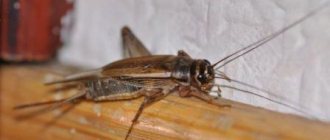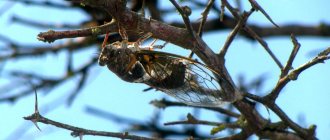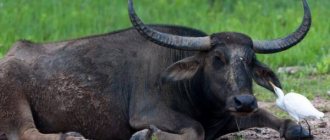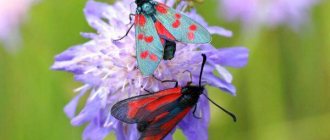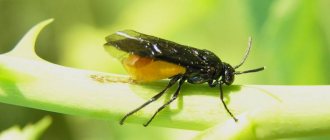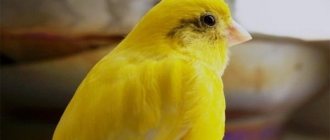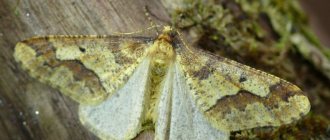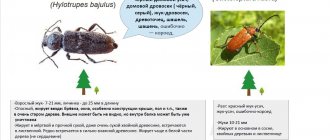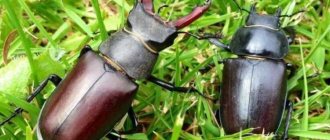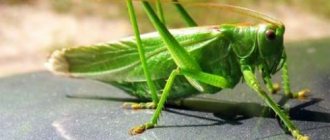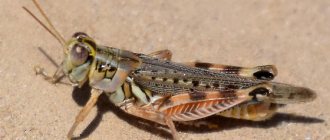- Wild animals
- >>
- Insects
Locusts are one of the most dangerous insects for the national economy. The pest of agricultural and wild crops is widespread throughout the planet. Once upon a time, in ancient times, locust raids not only destroyed crops, but could lead to starvation of an entire people. A single individual is completely harmless, but when it joins the ranks of a flock, it easily destroys all crops in its path.
What does an insect look like?
Locusts, a group of locusts, are a fairly large pest, 3 cm long and resembling a grasshopper.
Its elongated body is covered on the sides by hard elytra, often colored to match the area in which the insect lives. The color of individuals can be brown, yellowish or green .
The female has an ovipositor in the form of a pointed spike at the end of her body.
Interesting ! The color of locusts is camouflage. It is different even among closely related insects and depends not only on the type of pest, but also on the palette of the environment, the nature of nutrition, and humidity.
In the Asian locust, for example, even the gregarious and solitary forms have different appearances.
Ways to fight
If there are not many pests, mechanical cleaning can be used. It is necessary to collect and destroy the larvae in the soil; this is effective only in the early stages.
Digging. It does not always bring results, since it is not possible to remove all the larvae. It is more effective when introducing chemicals to destroy egg laying.
Burning out. In this way you can get rid of clutches of eggs that are shallow in the soil. To increase the depth of heating, the soil surface is covered with straw or peat. To increase the effect, the soil is dug up so that the remaining larvae die during the winter.
Chemical treatment. In specialized stores you can purchase special compounds suitable for locusts. Treatment is carried out in early spring before sowing, since chemical treatment negatively affects the quality of grown products.
Locusts are quite resistant to chemicals, so the plants they feed on are treated. But even the most powerful poisons cannot always get rid of pest infestations.
Timely preventive and protective actions will help save your harvest.
Photo
For a visual assessment of what locusts look like, photo below:
Hordes of locusts hit the southern regions of Russia. Video (00:02:52)
In the south of Russia, all efforts are being devoted to the fight against locusts. There are more and more invasive insects; crops are already suffering from them in several regions. For example, in the Stavropol region, the current migration of giant grasshoppers is the largest in several years.
The population is so large that it is impossible even to simply walk along the road without stepping on an insect. Now these locusts are about three weeks old, and they can travel up to 15 kilometers in a day. And in a few days their wings will grow and this distance will increase to 50 kilometers.
In the eastern part of the region, where the Stavropol region borders on the steppes of Dagestan and Kalmykia, most of the land of the Levokomsky district is allocated for pastures. That's why these fields are never plowed. The locusts, which lay their larvae in the ground, reproduce very actively and begin to move to where there is more food - to the west.
Locust and grasshopper: differences
Let's find out the difference between a locust and a grasshopper:
- The grasshopper's whiskers are longer than those of the locust and rise strongly above the head;
- Nature has awarded the grasshopper with longer limbs and massive hind legs - it is better adapted for jumping.
Despite their external similarity, these two insects belong to different orders - grasshoppers and locusts. The former are representatives of the long-whiskered suborder; the locust belongs to the short-whiskered suborder.
There are also differences in the lifestyle of the grasshopper and the locust:
- short mustaches are herbivores , and representatives of grasshoppers are predators;
- locusts are diurnal , raiding crops in broad daylight; long-legged jumpers are considered nocturnal insects;
- grasshoppers lay eggs on the ground parts of plants , and locust pests lay eggs in the soil.
Interesting Facts
Among the features of the structure and life of locusts, many interesting facts can be identified:
- Due to the fact that the insect has well-developed hind legs, it can move a distance twenty times its body size in one jump.
- When eating, locusts eat everything that is colored green. As soon as food that has greenish tints runs out in a closed room, the locust begins to eat its relatives if they are green in color.
- Insects can fly over vast spaces without landing - up to four hundred kilometers. The longest flight of a swarm of locusts is from the African continent to the islands of the Caribbean Sea. A herd of locusts walking on foot covers an area of twenty kilometers during daylight hours.
- 7,000 tons of citrus fruits were swallowed in 5 days by a community of locusts that attacked an orange plantation in Morocco. Amazing gluttony - one ton per minute.
- Locust is an insect that inhabits all continents of the globe, with the exception of Antarctica. This is due to harsh climatic conditions and a complete lack of food. But an interesting fact is that they are not available in North America. The last known locust outbreak on the continent was in 1875.
- The most unusual way to fight locusts was recorded in the 15th century in France. The judge who was considering the case of damage to the vineyards by insects made a decision to allocate them a plot of land, which the pests were strictly forbidden to leave.
- Locusts are on the menu of many peoples of the world. These insects are eaten in thirty-six countries located on the African continent, twenty-nine Asian countries and twenty-three countries on the South American continent. Research has proven that locusts are a nutritious food that can replace meat, they are low in fat and high in vitamins.
What plants does it affect?
The pest is unpretentious in food , it eats the ground parts of vegetable plants, cereals, melons, attacks orchards, berry fields, wild trees, not disdaining reed plants.
Leaves, stems, shoots, even the bark of young trees serve as food .
You can learn more about the taste preferences of the merciless insect in the section devoted to its nutrition.
Interesting ! The older an insect gets, the more varied the food it eats becomes. Seasoned individuals are practically omnivorous.
WHAT DOES IT EAT?
Locusts usually live on the leaves and flowers of green plants. They use their strong upper mandibles to gnaw leaves, and use their smaller, weaker mandibles to crush them.
Since the locusts' mandibles move from side to side, the insects usually sit in the center of the leaf, on its longitudinal axis, and gnaw the leaf from edge to edge. Only a few species of true locusts feed exclusively on grass. The food for most locust species is the leaves of perennial plants, shrubs and trees. Some species of locusts can even feed on poisonous plants that other insects and animals do not eat.
Concentrating in their body, the poison provides insects with protection from enemies, since they themselves become poisonous. These locusts have bright colors, which warns of their inedibility.
Kinds
There are several types of locusts, which differ in appearance and size. The name of the giant locust itself suggests that these insects have a record large size - up to 20 cm . The pest lives in the hot climate of South America.
In Russia, green locusts are found everywhere, resembling a grasshopper - an assistant to farmers and gardeners.
The inconspicuous omnivorous Moroccan pest is very dangerous due to its ability to quickly adapt to insecticides and cause great economic damage.
Capable of migrating in search of a climate suitable for reproduction, the desert locust is known for the fact that the amount of greenery consumed by an individual is equal to its weight .
FEATURES OF THE DEVICE
All types of locusts produce a characteristic “chirping” sound. This peculiar “singing” of insects brings to mind for many people the image of a flowering meadow on a hot summer day. The sound apparatus of locusts is located on the thighs of the hind legs and elytra. Tubercles stretch along the inner surface of the thigh, and one of the veins of the elytra is thicker than the others. Locusts make sounds by quickly moving their hips, with the tubercles touching the vein. Because the tubercles are uneven, the result is a staccato chirping sound. In most locust species, both males and females chirp.
Reproduction
Mating of pests in a favorable climate can occur from 5 to 12 times a year .
After mating and fertilization, the female lays eggs in the soil , from which larvae will be born after 2 weeks - smaller copies of adult insects.
In the section on locust reproduction you can see photos of insect eggs and larvae.
Nutrition
Single individuals do not cause catastrophic damage to green spaces. Singles have a very moderate appetite. During their entire life, they eat no more than five hundred grams of green mass. The main problem is the locusts that have united in a swarm.
To replenish the energy balance and vitality, individuals gathered in a herd are forced to eat without stopping, otherwise they will die from thirst and lack of protein. The locust, finding itself in the company of numerous relatives, begins to show amazing gluttony. One individual is capable of absorbing about four hundred grams of green mass per day, but there are millions of them in a flock.
With a lack of protein in the body, insects begin to degenerate into predators, and the process of eating their own kind begins. In this case, the flock is divided into two symbolic subgroups, one of which runs ahead, and the second tries to catch up and eat. Both those escaping and those catching up eat everything in their path, completely destroying crops and gardens.
Locusts are pests . The multimillion-dollar community will leave behind bare ground with the occasional remnant of protruding stems. Individuals have a better appetite in the absence of heat (morning and evening).
Where does it live?
These unpretentious insects do not have any specific and limited habitat. They can be found throughout the entire globe, only the species will differ, but even between them there are no significant differences, which means that locusts still remain locusts. The only place on the entire planet where insects cannot reach is the coldest continent - Antarctica. In other climatic zones, from the tropics and subtropics to Western Siberia and Sakhalin, these herbivores can be found.
Some species settle close to crops, others - remotely, in the mountains or near water bodies. There are as many variations in lifestyle and habitat as there are varieties of the most common insect on Earth, but all this is just conventions and specifics, which in some cases you don’t have to go into. Even in the driest deserts, such as the Sahara, where there are basically no plants except dead bushes, locusts can still be found.
DANGEROUS LOCUST. GIANT LOCUST EATING. Video (00:02:10)
DANGEROUS LOCUST. GIANT LOCUST EATING. Locust invasion. Giant locust. Locusts eat the crops. Locusts are arthropods, class - insects, locust family. Locusts usually live on roadsides. The giant locust is a larger type of grasshopper. Dangerous Locusts gather in huge swarms, destroying all plants, These are hunger games. Locusts are dangerous. There are swarms of locusts of up to 40 billion individuals. The locust's favorite food is cereals. Due to lack of food, locusts eat all vegetation. The enemies of locusts and grasshoppers are starlings, storks, and larks. In some countries, locusts are eaten, cooked in oil, and locusts are a delicacy. Locusts gather in swarms - migratory locusts.
Natural enemies
The only representatives of the world's fauna that are able to give at least some resistance to locusts are birds, for example, starlings, larks or storks. Only they have the means and the ability to resist insect fillies that have not yet entered the gregarious phase. But this very transition neutralizes all attempts to fight and literally condemns all nearby cultures to death. Birds simply cannot resist the huge number of herbivorous insects that form herds that resemble clouds.
Starling is the enemy of locusts
HORROR! LOCUST ATTACK IN STAVROPOL. THIS HAS NOT HAPPENED FOR 30 YEARS / Life life TV. Video (00:03:10)
An invasion that is gaining catastrophe proportions every day! The Stavropol region is being attacked by hordes of locusts. The fight is going on both on the ground and from the air, but chemicals cannot resist the giant swarms of pests that devour hectares of crops in their path. There has not been such migration of insects in the region for the last 30 years. There are so many locusts that it dazzles your eyes! Insects have been plaguing the Stavropol region for several days now. And if the townspeople jokingly fight them with slippers, then in the villages the pests will make you cry.
Structure
The body structure of this insect is very similar to others, but the oral apparatus is noticeably different. It is a gnawer and has all the necessary elements for proper nutrition with solid food. This type is considered to be the original for most other animals, in principle, since locusts still remain one of the most ancient insects. The gnawing apparatus contains a full set of elements for cutting and primary digestion of solid plants - two lips, upper and lower, under which there are two pairs of lower and upper jaws without teeth.
Giant locust
Thanks to the upper lip, this animal checks potential food for suitability, after which it grabs a small piece, moving exclusively in the horizontal plane, and then bites off and breaks it into even smaller pieces. The lower jaws serve as a kind of spring, thanks to which the crushed food is pushed into the pharynx, and then into the esophagus.
